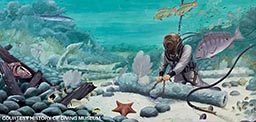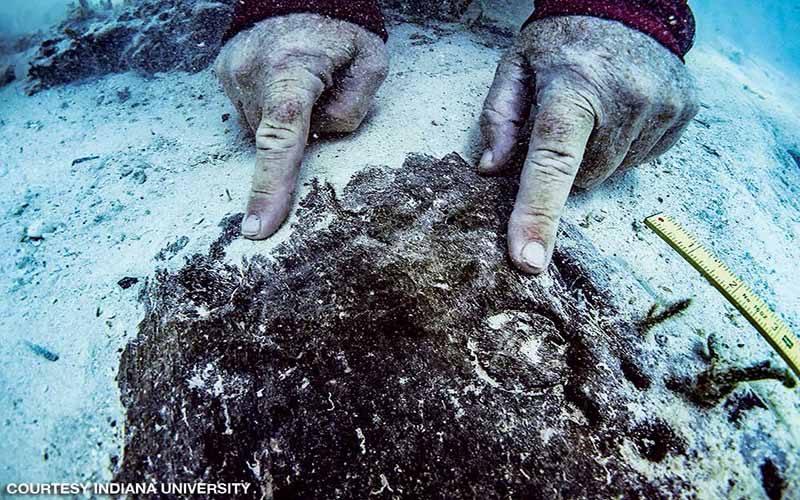In the mid-1980s in the shallow waters of the Florida Keys, just a mile from Lower Matecumbe Key, archaeologist Charles Beeker and biologist Bill Ruf first teamed up to work on the shipwrecks San Pedro and San Felipe. Their research, which emphasized the protection of both the submerged cultural resources and their associated biodiversity, provided the basis for the establishment of the San Pedro Underwater Archaeological Preserve and was instrumental in the establishment by the National Oceanic Atmospheric Administration (NOAA) of the Florida Keys National Marine Sanctuary Shipwreck Trail. Thirty years later, in the summer of 2018, Beeker and Ruf are still returning to the San Pedro and San Felipe wrecks, and they are still preaching the same message of preservation — that the creation of underwater parks is paramount to preserving the finite cultural and biological resources of our oceans for future generations.

The 1733 New Spain Fleet
The New Spain fleet under the command of Don Rodrigo de Torres left Havana Harbor on Friday, July 13, 1733, to return to Spain with treasures from the New World. Encountering a hurricane passing through the Florida Keys the next day, the fleet was unable to turn back to Havana; most of the fleet was scattered and sunk along 80 miles of Florida coast in one of history’s most devastating maritime disasters.
Since the early 1960s divers have successfully located most of the wrecks associated with the 1733 fleet. Unfortunately the archaeological integrity of many of these shipwrecks has been damaged by treasure hunting and looting. Beeker, an archaeologist and director of the Center for Underwater Science at Indiana University, explained, “These shipwrecks are important time capsules of human history, and it is the responsibility of both archaeologists and sport diving communities to instill an appreciation for these fragile, nonrenewable resources.”
San Pedro Underwater Archaeological Preserve
Indiana University (IU) and Florida State University (FSU) collaborated in the summer of 1988 to assess the 1733 shipwreck sites as potential candidates for the creation of a new marine protected area (MPA) that would protect the site as both an archaeological preserve and public shipwreck park. After looking at several different 1733 shipwreck sites, the researchers chose the San Pedro as the best prospect for the creation of the San Pedro Underwater Archaeological Preserve.
In April 1989 the San Pedro Underwater Archaeological Preserve officially opened to the public. The San Pedro’s rich history and biodiversity, as well as its close proximity to the state parks on Lignumvitae Key and Indian Key, make the park a popular attraction for snorkelers, diving charters and sportfishing guides.
San Felipe: A Galleon Frozen in Time
Less than a mile from the San Pedro’s busy park is the silent resting place of the San Felipe. Sitting on deck after a dive on the San Felipe, watching the heavy boat traffic around the San Pedro, you can imagine the chaos of July 14, 1733, unfold as the crew of the San Felipe watched the San Pedro sink while desperately fighting to avoid the same fate.

Unlike the San Pedro, treasure hunters have only minimally affected the San Felipe (also known as the El Terri). The original surveys by Beeker and IU colleagues in the 1980s show not only that the San Felipe had intact and exposed wooden timbers but also that the ship’s ballast pile was intact. The San Felipe’s articulated ballast stones provide a stable substrate for coral growth, and the ship’s relatively undisturbed remains make it an ideal example of an early 18th-century shipwreck.
30 Years of Research
Beeker and his team of researchers are currently partnering with the Florida Keys National Marine Sanctuary (FKNMS) to return to these sites and examine both human and environmental impacts over time on the cultural and biological resources of the 1733 shipwrecks. IU has worked closely with NOAA over the past 30 years to document and monitor these sites. These comparative data are of paramount importance to tracking changes in these historic underwater resources.

“We have to know what we had in order to fully understand what we have,” Beeker said. Reviewing the data from 30 years of monitoring gives IU and NOAA researchers invaluable perspective on managing these important resources.
This summer Beeker assembled a multidisciplinary team of researchers, including IU geologist Claudia Johnson and NOAA archaeologist Matthew Lawrence, to revisit the San Pedro and San Felipe and continue the longstanding research and collaboration with the FKNMS.
18th-Century Shipwrecks, 21st-Century Technology
Current research by IU and NOAA on the San Pedro and San Felipe uses a relatively new and exciting technique called structure-from-motion photogrammetry. The core idea behind this technology is that with enough 2-D pictures of an object or area, specialized computer software can stitch together those images and create a 3-D model. The resulting 3-D models are highly accurate, usually to within less than a centimeter of error.
This new technology allows divers to quickly and comprehensively document an entire shipwreck site, leaving more time for researchers to study minute changes in the site from year to year. After Hurricane Irma in 2017, devastation to coral reef ecosystems throughout the Florida Keys was widely documented and apparent, but the storm’s impact on cultural resources and their preservation was less obvious.

One of the most noticeable changes to these 1733 shipwreck sites after the storm was the uncovering of a large amount of previously undocumented hull remains on the San Felipe. Researchers mapped and plotted the exposed wood timbers using computer vision photogrammetry, and the findings could reveal important clues about the San Felipe’s construction and fate.
The IU and NOAA team also rediscovered one of the replica cannons on the San Pedro that was lost in the sand after Hurricane Andrew in 1992. Strong currents and storm-force waves from Hurricane Irma uncovered the lost Cannon #5, which IU divers relocated to the park site in 2018.
Looking to the Future
“One of the most pressing environmental concerns of our time is the deteriorating health of Earth’s natural ecosystems under a warming climate,” explained Johnson, an evolutionary paleoecologist and associate director of IU’s Center for Underwater Science. “We are beginning to cause irreversible damage to the cultural and biological resources of our planet’s oceans. It is of the utmost importance to have historical comparative data to track changes to these underwater resources.”
Beeker, Ruf, Johnson and IU’s Center for Underwater Science are still fighting for proper protection and management of archaeological sites such as the 1733 wrecks San Pedro and San Felipe and their associated biological resources. The researchers hope this work will not only improve the way we interact with the natural underwater world but also preserve the sites for future generations.
Explore More
| © Alert Diver — Q4 2018 |